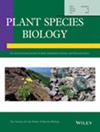Variation in degree of intermediate complex morphophysiological dormancy in seeds of Bunium persicum (Apiaceae)
IF 1.3
4区 生物学
Q4 ECOLOGY
引用次数: 0
Abstract
Bunium persicum is an important medicinal plant, but the requirements for seed dormancy break and germination are not well known. Based on available information, we hypothesized that seeds have an underdeveloped embryo and physiological dormancy (PD), and hence morphophysiological dormancy (MPD), and that populations of this species may have different degrees of MPD which demand different germination requirements. In this study, we evaluated embryo growth in seeds from four B. persicum populations at different temperatures and tested germination at varying constant temperatures, with or without GA3 and cold stratification. Seeds from the four populations had a fully differentiated, small, linear but underdeveloped embryo. The initial embryo‐to‐seed length ratio was 0.14–0.17, but it increased to 0.71–0.75 before germination at 5°C. Little embryo growth occurred at 15°C and no growth occurred at 25°C. GA3 effectively increased germination percentages, replaced cold stratification, reduced the required period for cold stratification, and in combination with cold stratification increased the maximum temperature of germination. Therefore, seeds from the four populations have intermediate complex MPD. Additionally, the germination responses of seeds from the four populations to GA3, cold stratification, or both were different, suggesting variation in the degree of PD. Bunium persicum seeds developed in cool and wet conditions were more dormant than those developed under warm and dry conditions. Thus, we showed that different climates can affect the depth of PD in a species whose seeds have MPD, resulting in variation in the degree of intermediate complex MPD at the population level.猕猴桃种子中间复杂形态生理休眠程度的变化
摘要仙桃是一种重要的药用植物,但对其种子休眠和萌发的要求尚不清楚。根据现有资料,我们推测种子具有发育不全的胚胎和生理休眠(PD),从而具有形态生理休眠(MPD),并且该物种的种群可能具有不同程度的MPD,需要不同的萌发要求。在本研究中,我们对4个桃香居群种子在不同温度下的胚胎生长情况进行了研究,并对不同恒温条件下、加或不加ga3和冷分层的萌发情况进行了测试。来自四个居群的种子具有完全分化的小的、线形的但发育不全的胚。初始胚与种子的长度比为0.14 ~ 0.17,但在5℃萌发前增加到0.71 ~ 0.75。在15°C时,胚胎几乎没有生长,在25°C时,胚胎没有生长。GA 3有效地提高了种子的发芽率,代替了冷分层,缩短了冷分层所需的时间,并与冷分层联合使用,提高了种子的最高萌发温度。因此,这四个居群的种子具有中等复杂的MPD。此外,4个群体的种子对GA 3、冷分层或两者的萌发反应不同,表明PD程度存在差异。在凉爽和潮湿条件下发育的仙桃种子比在温暖和干燥条件下发育的种子更休眠。因此,我们发现不同的气候会影响种子具有MPD的物种的PD深度,导致种群水平上中间复杂MPD程度的变化。
本文章由计算机程序翻译,如有差异,请以英文原文为准。
求助全文
约1分钟内获得全文
求助全文
来源期刊

Plant Species Biology
生物-生态学
CiteScore
2.70
自引率
14.30%
发文量
36
审稿时长
>12 weeks
期刊介绍:
Plant Species Biology is published four times a year by The Society for the Study of Species Biology. Plant Species Biology publishes research manuscripts in the fields of population biology, pollination biology, evolutionary ecology, biosystematics, co-evolution, and any other related fields in biology. In addition to full length papers, the journal also includes short research papers as notes and comments. Invited articles may be accepted or occasion at the request of the Editorial Board. Manuscripts should contain new results of empirical and/or theoretical investigations concerning facts, processes, mechanisms or concepts of evolutionary as well as biological phenomena. Papers that are purely descriptive are not suitable for this journal. Notes & comments of the following contents will not be accepted for publication: Development of DNA markers. The journal is introducing ''Life history monographs of Japanese plant species''. The journal is dedicated to minimizing the time between submission, review and publication and to providing a high quality forum for original research in Plant Species Biology.
 求助内容:
求助内容: 应助结果提醒方式:
应助结果提醒方式:


